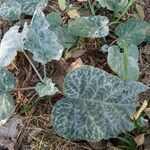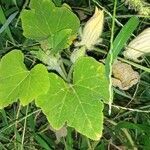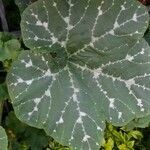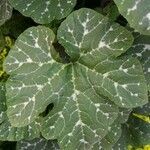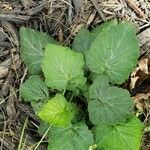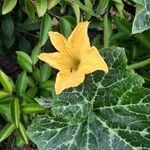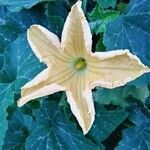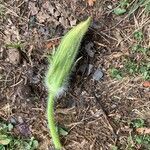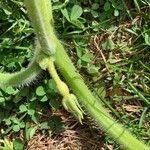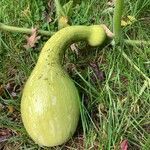A pumpkin family plant. It is a creeping plant with long creeping stems and softly hairy but without prickly hairs. The stem are rounded or 5 angled and moderately hard. They can grow 15-20 m long. The leaves are large and shallowly lobed and divided like fingers on a hand. Occasionally the leaves have white blotches. They have rounded lobes. They are 20 cm by 30 cm. The leaf stalk is 12-30 cm long. The flowers have male and female flowers separately on the same plant. The fruit stalk is distinctly expanded there it joins the fruit. The fruit are not hard shelled and are dull in colour. The flesh is yellow. Often the flesh has fibres through it. The seeds are plump and white to brown. They separate easily from the pulp of the fruit. The edge of the seed is scalloped and irregular in outline. There are a large number of cultivated varieties.
Plants prostrate. Stem to 2-5 m, densely white setose. Petiole robust, 8-19 cm, setose; leaf blade broadly ovate or ovate-orbicular, 12-25 × 20-30 cm, 5-angled or 5-lobed; lobes triangular, adaxially yellow-white setose and velvety. Male calyx tube campanulate, 5-6 mm; segments linear, 1-1.5 cm, pubescent, enlarged or leaflike at apex; corolla campanulate, ca. 8 × 6 cm; segments with revolute margin, rugose, apex acute; stamens 3; filaments 5-8 mm, glandular; anthers connivent, ca. 15 mm. Ovary 1-locular; style short; stigma enlarged, 2-lobed. Fruiting pedicel robust, 5-7 cm, angular-sulcate, strongly enlarged at apex; fruit variable in shape, size, and color. Seeds numerous, gray-white, ovate or oblong, 10-15 × 7-10 mm, margin thickened. Fl. and fr. Apr-Nov.
Plants including leaves pubescent, not scabrous. Leave blades lobed, lobes acute or obtuse. Male flowers: pedicel subterete; receptacle-tube short-campanulate; sepals mostly linear. Female flowers pedicel ± angular; receptacle-tube as in male flowers; sepals ± linear or mostly leaf-like broadened at apex (long clawed). Fruit (depressed) globose, elongated or flask-shaped, often shallowly furrowed (sulcate) from apex to base of fruiting pedicel; fruiting pedicel angled, distinctly broadened at the transition to the fruit. Seeds variable in size, 10-15(-20) mm long.
